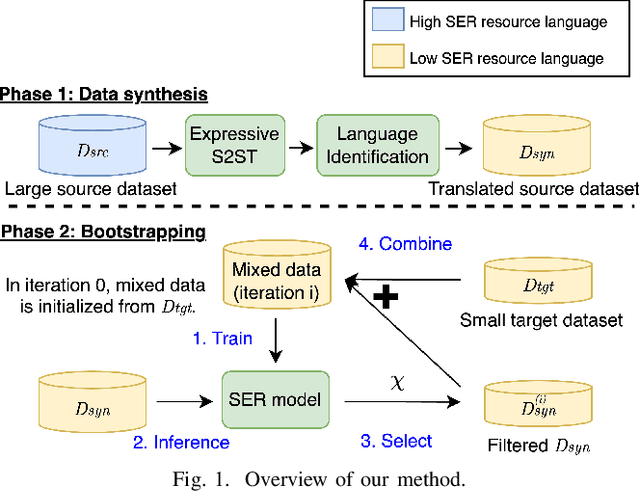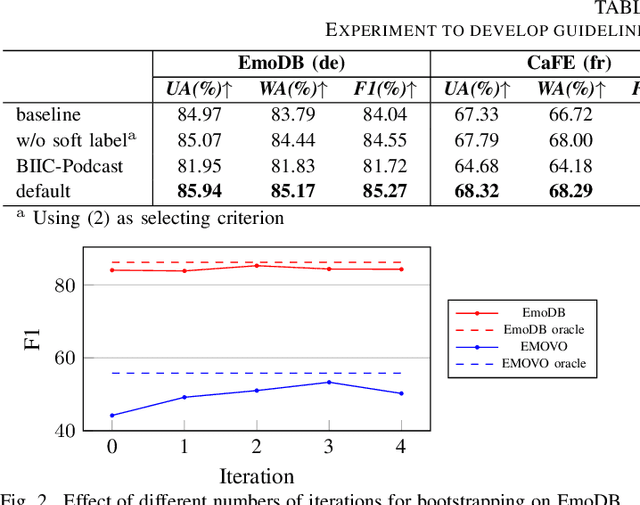Huang-Cheng Chou
Do You Hear What I Mean? Quantifying the Instruction-Perception Gap in Instruction-Guided Expressive Text-To-Speech Systems
Sep 18, 2025Abstract:Instruction-guided text-to-speech (ITTS) enables users to control speech generation through natural language prompts, offering a more intuitive interface than traditional TTS. However, the alignment between user style instructions and listener perception remains largely unexplored. This work first presents a perceptual analysis of ITTS controllability across two expressive dimensions (adverbs of degree and graded emotion intensity) and collects human ratings on speaker age and word-level emphasis attributes. To comprehensively reveal the instruction-perception gap, we provide a data collection with large-scale human evaluations, named Expressive VOice Control (E-VOC) corpus. Furthermore, we reveal that (1) gpt-4o-mini-tts is the most reliable ITTS model with great alignment between instruction and generated utterances across acoustic dimensions. (2) The 5 analyzed ITTS systems tend to generate Adult voices even when the instructions ask to use child or Elderly voices. (3) Fine-grained control remains a major challenge, indicating that most ITTS systems have substantial room for improvement in interpreting slightly different attribute instructions.
EMO-Reasoning: Benchmarking Emotional Reasoning Capabilities in Spoken Dialogue Systems
Aug 25, 2025Abstract:Speech emotions play a crucial role in human-computer interaction, shaping engagement and context-aware communication. Despite recent advances in spoken dialogue systems, a holistic system for evaluating emotional reasoning is still lacking. To address this, we introduce EMO-Reasoning, a benchmark for assessing emotional coherence in dialogue systems. It leverages a curated dataset generated via text-to-speech to simulate diverse emotional states, overcoming the scarcity of emotional speech data. We further propose the Cross-turn Emotion Reasoning Score to assess the emotion transitions in multi-turn dialogues. Evaluating seven dialogue systems through continuous, categorical, and perceptual metrics, we show that our framework effectively detects emotional inconsistencies, providing insights for improving current dialogue systems. By releasing a systematic evaluation benchmark, we aim to advance emotion-aware spoken dialogue modeling toward more natural and adaptive interactions.
DeSTA2.5-Audio: Toward General-Purpose Large Audio Language Model with Self-Generated Cross-Modal Alignment
Jul 03, 2025Abstract:We introduce DeSTA2.5-Audio, a general-purpose Large Audio Language Model (LALM) designed for robust auditory perception and instruction-following, without requiring task-specific audio instruction-tuning. Recent LALMs typically augment Large Language Models (LLMs) with auditory capabilities by training on large-scale, manually curated or LLM-synthesized audio-instruction datasets. However, these approaches have often suffered from the catastrophic forgetting of the LLM's original language abilities. To address this, we revisit the data construction pipeline and propose DeSTA, a self-generated cross-modal alignment strategy in which the backbone LLM generates its own training targets. This approach preserves the LLM's native language proficiency while establishing effective audio-text alignment, thereby enabling zero-shot generalization without task-specific tuning. Using DeSTA, we construct DeSTA-AQA5M, a large-scale, task-agnostic dataset containing 5 million training samples derived from 7,000 hours of audio spanning 50 diverse datasets, including speech, environmental sounds, and music. DeSTA2.5-Audio achieves state-of-the-art or competitive performance across a wide range of audio-language benchmarks, including Dynamic-SUPERB, MMAU, SAKURA, Speech-IFEval, and VoiceBench. Comprehensive comparative studies demonstrate that our self-generated strategy outperforms widely adopted data construction and training strategies in both auditory perception and instruction-following capabilities. Our findings underscore the importance of carefully designed data construction in LALM development and offer practical insights for building robust, general-purpose LALMs.
CO-VADA: A Confidence-Oriented Voice Augmentation Debiasing Approach for Fair Speech Emotion Recognition
Jun 06, 2025Abstract:Bias in speech emotion recognition (SER) systems often stems from spurious correlations between speaker characteristics and emotional labels, leading to unfair predictions across demographic groups. Many existing debiasing methods require model-specific changes or demographic annotations, limiting their practical use. We present CO-VADA, a Confidence-Oriented Voice Augmentation Debiasing Approach that mitigates bias without modifying model architecture or relying on demographic information. CO-VADA identifies training samples that reflect bias patterns present in the training data and then applies voice conversion to alter irrelevant attributes and generate samples. These augmented samples introduce speaker variations that differ from dominant patterns in the data, guiding the model to focus more on emotion-relevant features. Our framework is compatible with various SER models and voice conversion tools, making it a scalable and practical solution for improving fairness in SER systems.
EMO-Debias: Benchmarking Gender Debiasing Techniques in Multi-Label Speech Emotion Recognition
Jun 05, 2025Abstract:Speech emotion recognition (SER) systems often exhibit gender bias. However, the effectiveness and robustness of existing debiasing methods in such multi-label scenarios remain underexplored. To address this gap, we present EMO-Debias, a large-scale comparison of 13 debiasing methods applied to multi-label SER. Our study encompasses techniques from pre-processing, regularization, adversarial learning, biased learners, and distributionally robust optimization. Experiments conducted on acted and naturalistic emotion datasets, using WavLM and XLSR representations, evaluate each method under conditions of gender imbalance. Our analysis quantifies the trade-offs between fairness and accuracy, identifying which approaches consistently reduce gender performance gaps without compromising overall model performance. The findings provide actionable insights for selecting effective debiasing strategies and highlight the impact of dataset distributions.
Meta-PerSER: Few-Shot Listener Personalized Speech Emotion Recognition via Meta-learning
May 22, 2025Abstract:This paper introduces Meta-PerSER, a novel meta-learning framework that personalizes Speech Emotion Recognition (SER) by adapting to each listener's unique way of interpreting emotion. Conventional SER systems rely on aggregated annotations, which often overlook individual subtleties and lead to inconsistent predictions. In contrast, Meta-PerSER leverages a Model-Agnostic Meta-Learning (MAML) approach enhanced with Combined-Set Meta-Training, Derivative Annealing, and per-layer per-step learning rates, enabling rapid adaptation with only a few labeled examples. By integrating robust representations from pre-trained self-supervised models, our framework first captures general emotional cues and then fine-tunes itself to personal annotation styles. Experiments on the IEMOCAP corpus demonstrate that Meta-PerSER significantly outperforms baseline methods in both seen and unseen data scenarios, highlighting its promise for personalized emotion recognition.
Mitigating Subgroup Disparities in Multi-Label Speech Emotion Recognition: A Pseudo-Labeling and Unsupervised Learning Approach
May 21, 2025Abstract:While subgroup disparities and performance bias are increasingly studied in computational research, fairness in categorical Speech Emotion Recognition (SER) remains underexplored. Existing methods often rely on explicit demographic labels, which are difficult to obtain due to privacy concerns. To address this limitation, we introduce an Implicit Demography Inference (IDI) module that leverages pseudo-labeling from a pre-trained model and unsupervised learning using k-means clustering to mitigate bias in SER. Our experiments show that pseudo-labeling IDI reduces subgroup disparities, improving fairness metrics by over 33% with less than a 3% decrease in SER accuracy. Also, the unsupervised IDI yields more than a 26% improvement in fairness metrics with a drop of less than 4% in SER performance. Further analyses reveal that the unsupervised IDI consistently mitigates race and age disparities, demonstrating its potential in scenarios where explicit demographic information is unavailable.
Improving Speech Emotion Recognition in Under-Resourced Languages via Speech-to-Speech Translation with Bootstrapping Data Selection
Sep 17, 2024



Abstract:Speech Emotion Recognition (SER) is a crucial component in developing general-purpose AI agents capable of natural human-computer interaction. However, building robust multilingual SER systems remains challenging due to the scarcity of labeled data in languages other than English and Chinese. In this paper, we propose an approach to enhance SER performance in low SER resource languages by leveraging data from high-resource languages. Specifically, we employ expressive Speech-to-Speech translation (S2ST) combined with a novel bootstrapping data selection pipeline to generate labeled data in the target language. Extensive experiments demonstrate that our method is both effective and generalizable across different upstream models and languages. Our results suggest that this approach can facilitate the development of more scalable and robust multilingual SER systems.
Stimulus Modality Matters: Impact of Perceptual Evaluations from Different Modalities on Speech Emotion Recognition System Performance
Sep 16, 2024Abstract:Speech Emotion Recognition (SER) systems rely on speech input and emotional labels annotated by humans. However, various emotion databases collect perceptional evaluations in different ways. For instance, the IEMOCAP dataset uses video clips with sounds for annotators to provide their emotional perceptions. However, the most significant English emotion dataset, the MSP-PODCAST, only provides speech for raters to choose the emotional ratings. Nevertheless, using speech as input is the standard approach to training SER systems. Therefore, the open question is the emotional labels elicited by which scenarios are the most effective for training SER systems. We comprehensively compare the effectiveness of SER systems trained with labels elicited by different modality stimuli and evaluate the SER systems on various testing conditions. Also, we introduce an all-inclusive label that combines all labels elicited by various modalities. We show that using labels elicited by voice-only stimuli for training yields better performance on the test set, whereas labels elicited by voice-only stimuli.
EMO-Codec: An In-Depth Look at Emotion Preservation capacity of Legacy and Neural Codec Models With Subjective and Objective Evaluations
Jul 30, 2024



Abstract:The neural codec model reduces speech data transmission delay and serves as the foundational tokenizer for speech language models (speech LMs). Preserving emotional information in codecs is crucial for effective communication and context understanding. However, there is a lack of studies on emotion loss in existing codecs. This paper evaluates neural and legacy codecs using subjective and objective methods on emotion datasets like IEMOCAP. Our study identifies which codecs best preserve emotional information under various bitrate scenarios. We found that training codec models with both English and Chinese data had limited success in retaining emotional information in Chinese. Additionally, resynthesizing speech through these codecs degrades the performance of speech emotion recognition (SER), particularly for emotions like sadness, depression, fear, and disgust. Human listening tests confirmed these findings. This work guides future speech technology developments to ensure new codecs maintain the integrity of emotional information in speech.
 Add to Chrome
Add to Chrome Add to Firefox
Add to Firefox Add to Edge
Add to Edge